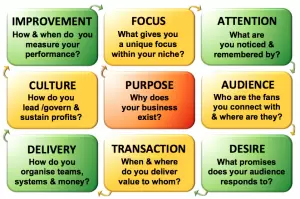
Christoff Oosthuysen
By the time you completed your business plan it may already be out-of-date. CHRISTOFF OOSTHUYSEN explains how to use a 1-page plan, as a comprehensive map” that can be refined as you go along, leading you to get bette-and-better so that you get improved results.
In the rapid-changing world of today, we need to plan for the next step towards our goals without always knowing the full path of getting to the desired destination.
This is pretty scary, since we must acknowledge that we will never know for certain exactly how things will pan out, even after completing our business plan.
Under these conditions, there is a big danger that you may focus on getting the things done you can see that must happen immediately since you do not wish to waste time on possibilities of the future that have a good chance of not becoming reality. Or you may alternatively be unsure what it is you need to do next, that you remain obsessed with the bigger idea, without getting down to action.
Start with why
I use a tool called the Flow Canvas when I work with businesses and organisations who understand that traditional ways of planning will not help them.
In the Flow Canvas, we place Purpose in the centre of the single page used for the plan and we first answer the question: Why does your business exist? The answer, of course, is not just to make money!
With a well-defined Purpose, you can ask yourself what you must do to achieve this bigger idea… and this is exactly what we do when following the Flow Canvas approach.
On a single page we draw four lines – two vertical and two horizontal – so that a grid is formed exactly like you would draw for playing naughts-and-crosses. This grid creates nine boxes and we use the central box to write down the Purpose we defined for the business.
The other eight elements revolve around the purpose, starting with Focus and ending in Improvement. Hereby, forming a cycle so that when you’ve gone through your first business cycle, you are equipped to use the same page in reviewing. You can then adjust your plans so that you can get better.
The Flow Canvas 1-page Plan gives you a very powerful tool to share your plans with your team, to show how the various elements of your plan and business fit together, get your team to act, and then to quickly review and adjust your plans for the next cycle.
Follow a cycle
In following the Flow Cycle (see the image below), you will see how the one element progresses to the next – it follows the natural path of “shifting energies” as described in ancient thinking about achieving good flow. This article is too short to go into this in depth.
However, you may know that the five questions used to offer a complete news article are What, Who, Where, How and Why.
These five questions are also the five energies found in ancient Chinese descriptions on how change happens naturally.
It is the same “shift in energy” that we plan for on the Flow Canvas, so that progress is achieved through the flow from one element of your plan to the next and the dynamic interaction between these elements.
Energetic influence
The biggest benefit of this dynamic influence between elements is that the clarity you have with one may help you define your plans for another element you may feel less confident about.
When you get stuck or your plans do not work out as you anticipated, you can use the dynamic energetic relationships between the elements to identify where the problem lies to solve.
- To download a free Flow Canvas planning framework CLICK HERE
- To find out about completing your plan in six hours go to www.FlowFinders.com/fc

DO YOUR PLAN
You can use the Flow Canvas to easily do your own plan. Draw the four lines on a page, then follow the sequence of questions, as explained below, from Purpose, to Focus, to Transaction, to Audience, to Attention, to Desire, to Delivery, to Culture and Improvement.
1. PURPOSE
Your purpose explains why your business exists and the difference you are making in the world. Purpose is different to the other elements as it endures over time; with the other elements, you attend to the activities for the next cycle of your plan. Your purpose remains your guiding light.
2. FOCUS
Your focus clarifies your uniqueness in terms of the specific idea that makes your business different to others and the distinctive value you create within your niche. Your focus is
all about the benefits you offer, rather than the people you
serve through what you do.
3. TRANSACTION
The element of transaction is where you exchange value. It is turning the benefit described in your focus into a value exchange. Here, you describe where and when you will be transacting with whom (for instance a price-list).
4. AUDIENCE
These are the people who benefit from what you offer and are attracted to your transactions. Since this is about identifying the people you serve, it is also important to clarify who those you are not to serve – you cannot be everything to everyone! Be very clear about who the people are you’re meant to serve.
5. ATTENTION
While your focus clarifies your uniqueness, attention allows you to explain this uniqueness and the benefits you offer. You are noticed through delivering a congruent message, appropriately positioned so that you are recognised where it matters.
6. DESIRE
When you have attracted your audience’s attention, you need to draw them closer so that they are unable to resist what you are offering. You achieve this by planning for the element of desire, where you remove the objections and obstacles in the way of people easily transacting with you.
7. DELIVERY
The element of delivery is about making good on what you promised. It is all about organising your teams, systems and money. Delivery is about meticulous planning of your operations, logistics and resources. With a “well-oiled machine” you’ll be able to prevent disappointments.
8. CULTURE
Your culture is about functioning as a sustainable organisation and the values guiding your accountabillity. You clarify how you organise yourself and your internal environment to maintain efficiencies and happiness.
9. IMPROVEMENT
With the improvement element, you identify the best ways for you to measure your performance so that you ensure that you keep contributing to your purpose. You also identify bottlenecks or inefficiencies in your cycle’s flow by quantifying key measures for each of the nine elements. The aim is to get better before the next cycle.
- Christoff Oosthuysen is a Certified Business Advisor (the highest level of accreditation) and Entrepreneurial Coach at Flow Finders International. He is also the Publisher of Small Business Connect.

